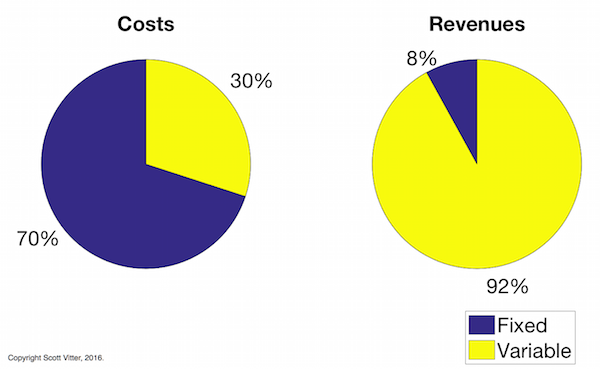This article was published in Scientific American’s former blog network and reflects the views of the author, not necessarily those of Scientific American
For consumers looking for cheaper, cleaner, and more local electricity generation, rooftop solar is a promising option. But even as installation costs continue to fall, the growth of distributed solar is threatened by other financial and technical barriers. Typical net metering rate structures can make it impossible for electricity providers to recover their costs in markets with a large penetration of rooftop solar. Meanwhile, solar panels can be prohibitively expensive to purchase. Even solar leasing companies such as SolarCity require a FICO credit score of at least 650, which excludes about 32 percent of U.S. population. Additionally, large amounts of rooftop solar make it difficult for utilities to maintain the stability of the local grid.
CPS Energy, the municipal utility of San Antonio, Texas, is pioneering a rooftop solar project that could overcome these barriers. The project, called SolarHost, allows any homeowner in the utility’s territory to apply for free solar panel installation. CPS Energy buys, installs, maintains, and insures the solar panels, and in return the customer leases their rooftop to the utility in exchange for a discounted electricity rate (saving 3 cents for each kilowatt-hour generated by the hosted panels, or about $20 per month on average). Customers seem to think this is a great deal—since SolarHost was announced in October 2015, CPS Energy has already filled its pilot program, receiving enough applications to accommodate over 150 megawatts of solar capacity
The SolarHost program is a clever solution to some financial barriers commonly encountered by rooftop solar programs. First, the electric utility gets customers’ solar energy for just three cents per kilowatt-hour versus the 10 cents per kilowatt-hour typically paid under net-metering programs, where solar panels essentially roll customers’ electric meters backwards. This helps CPS Energy partially solve the mismatch between fixed and variable costs versus revenues.
On supporting science journalism
If you're enjoying this article, consider supporting our award-winning journalism by subscribing. By purchasing a subscription you are helping to ensure the future of impactful stories about the discoveries and ideas shaping our world today.

Commonly, electric utilities operate with a mismatch between fixed and variable costs versus fixed and variable revenues. Policies that reduce electricity sales, such as net-metering, can prevent a utility from recovering its costs, which are largely fixed. Data from Smith, 2016.
Commonly, municipal utilities rely on variable revenues (think electricity sales) to recover fixed costs (think infrastructure). As Raiford Smith, former Vice President of Corporate Development and Planning at CPS Energy, points out, policies such as net-metering are “eating into the cost recovery for the assets themselves.” Under net-metering, rooftop solar can actually ruin the balance sheet of an electric utility. Second, lower-income homeowners can easily participate in SolarHost because they don’t need to purchase expensive solar panels or have the high credit scores required to lease them. Giving priority to poorer applicants could even be used to address income inequality. Third, homeowners don’t have to worry about all of the liabilities and upkeep associated with operating and maintaining their solar panels — since CPS Energy owns the panels, they take care of all that.
SolarHost also provides CPS Energy with a great opportunity to address solar-induced grid instabilities. Utilities must keep the distribution voltage near 120 volts to provide reliable power to their customers. However, conventional grids were not designed with solar in mind, and some solar generation characteristics, such as intermittent output and safety-triggered circuit trips, exacerbate voltage instability.
.png?w=600)
Solar inverters provide an interface between the electricity generated by solar panels and the electricity used by your home and on the grid. These inverters can be controlled in a way which reduces grid instability, especially if they are coordinate with other inverters in the local grid.
Inverters, the power electronics that connect solar panels to the rest of the grid, are technically capable of solving these instability issues, but they would need to be coordinated en masse across the distribution network. This type of coordination is problematic in a typical distribution grid where each inverter and solar array has a unique, independent owner. With the SolarHost program, however, CPS Energy will own thousands of smart inverters across its grid and could easily control them with voltage stability in mind. Moreover, they could prioritize installations in unstable parts of the network or in ways that reduce their reliance on (and maintenance of) traditional equipment, such as capacitors and voltage regulators.
Beyond the financial and technical benefits, SolarHost might also provide a new opportunity for CPS Energy to find additional revenue streams in the wholesale bulk-power market. The system operator props up the transmission grid with a number of “ancillary services,” which help maintain system reliability. These services are traditionally provided by power plants and large industrial customers, but a utility with centralized control of solar and inverter assets could conceivably provide these services as well. For example, control of smart inverters might allow CPS Energy to earn additional revenue by providing fast frequency response services to the system operator.
CPS Energy’s SolarHost program has a lot of potential for effectively increasing the amount of solar generation in the distribution network. It solves some of the financial problems associated with net metering and makes rooftop solar accessible to underserved demographics. Moreover, utility rights to smart inverter control provides additional tools for maintaining grid stability at lower costs. More work must be done to judge the technical and economic potential of using utility-owned rooftop solar to sell ancillary services to the transmission grid, but access to these markets could provide additional support for these programs in the future. Ultimately, the success of the SolarHost program will be an important gauge for the viability of utility-owned distributed solar generation. If it flourishes, other utilities will likely follow CPS’s example and we could be seeing a lot more solar panels in our neighborhoods soon.